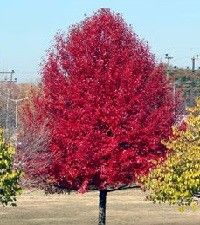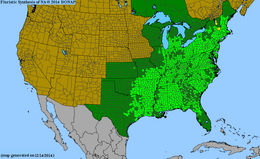Maryland DNR Recommended Tree and Deer-Resistant
The black gum, also commonly known as tupelo or black tupelo, is a medium-sized deciduous tree that is prized for its often spectacular autumnal coloring and its value to wildlife. It is slow-growing and often found in wet woods, where it typically reaches 30–50' feet. The bark is dark gray and flaky when young, but furrows with age to resemble alligator hide on the oldest stems. The small greenish-white flowers occur in May and June in clusters at the top of a long stalk. Honey made from the tupelo is prized for its sweetness. The foliage changes color as early as August, turning purple in Autumn, eventually becoming an intense bright scarlet. Deer love the leaves on seedlings and saplings, but for the most part will leave mature trees alone. This tree is difficult to transplant because of its large deep taproot; as a result, this tree is not commonly found in cultivation or in tree nurseries.
Black gum is native to eastern North America from the coastal Northeast south to central Florida and eastern Texas. It is found in a variety of upland and wetland habitats. Its flowers are an important source of wild honey, and its fruits are important to many birds and mammals. Black gum limbs and trunks often deterioriate early, creating hollows where bees and various mammals build nests or dens. The flowers are a rich source of nectar for bees. The small, dark blue fruits produced in Fall are very attractive to birds, especially the American robin. Host plant for the Hebrew moth, a leaf miner species, and a mite species.
BONAP Native Range Map (bright green indicates county native, dark green indicates state native)


